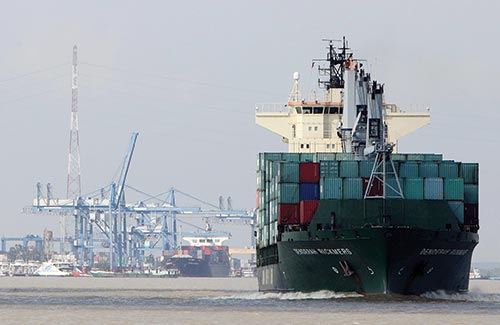Port expert advises on Cai Mep efficiency

Greater linkage and rerouting cargo out of Ho Chi Minh City would improve Cai Mep’s operational efficiency
Despite a several billion dollar investment and installation of cutting-edge equipment and technology, the operational efficiency of the southern province of Ba Ria-Vung Tau’s Cai Mep-Thi Vai deep-water seaport complex has proved below-par. The question is, how can this situation be turned around?
First, it is crucial to form common price sets for port services, diverse charges, synchronised development policies and the setup of a port authority model as well as links between ports in transport and associated infrastructure.
In fact, after five years of construction, a road project providing transport to the Cai Mep-Thi Vai area has not yet been completed. Another problem that needs to be tackled is that there are a number of mini terminals in Cai Mep area which are distant from each other, so it is important to shape a terminal chain, which helps to limit the time for processing and thereby attracts more vessels.
Second, there is a need to reduce the cargo volumes between Ho Chi Minh City and Ba Ria-Vung Tau. In fact, traffic congestion and stuck commodities at Ho Chi Minh City ports have plagued transporters and have been more frequent over recent months. Lines of trucks sitting idle along the Hanoi highway and specifically inter-provincial route 25B had significant social and economic impacts.
Once ports are opened in Cai Mep, management has a broader vision to dredge and expand into the sea. The port system however has yet to realise this vision and containers are still concentrated in Ho Chi Minh City ports.
Thailand once faced a similar situation. Initially, ports in the inner city held back Bangkok’s development and stressed already-existing traffic problems. To remedy the situation, the Thai government built a new deep-sea port, Laem Chabang, in the suburbs, about 90 minutes southeast of the city.
From that lesson Vietnam should take away the need to find suitable solutions, such as limiting the cargo volumes going through Ho Chi Minh City and moving them to Cai Mep-Thi Vai port complex to boost its efficiency.
Third is promoting connectivity between domestic inland waterways and ports in Cambodia, which shares the Mekong River with Vietnam. To turn Cai Mep-Thi Vai into a vibrant port venue, it is a must to ensure smooth transport to the Mekong Delta and links with ports in Cambodia’s Phnom Penh. That is one way to offset overloaded road transport and ease congestion at the Moc Bai Bordergate.
Towards this end, both countries’ transport authorities need to sit together to tackle administrative procedures, allowing ships to make entry/exit at river-way border gates. At present, port authorities and other agencies at the border work regular hours, they need to work later.
Vietnam’s seaport system and logistics supply chain is integral to the marine economic growth strategy and makes a remarkable contribution to the country’s GDP growth. In a broader sense, as Vietnam becomes a charming investment venue to multinationals and a destination of global ship alliances, the benefits will be enormous, not only economically, but also in terms of sovereignty and sea and island security.
What the stars mean:
★ Poor ★ ★ Promising ★★★ Good ★★★★ Very good ★★★★★ Exceptional
Latest News
More News
- Education reforms aid dealmaking appeal (December 03, 2025 | 10:07)
- Manufacturing deals bring stronger supply chains closer (December 03, 2025 | 09:34)
- Vietnam to limit raw rare earth exports (December 02, 2025 | 17:08)
- Japanese embassy marks 20 years of Japan-ASEAN bond market support (December 02, 2025 | 16:57)
- Phu Tho accelerates digital transformation to drive business growth (December 02, 2025 | 16:20)
- Vietnam-Czech collaboration to expand in key areas (December 02, 2025 | 15:36)
- GG Industries to produce high-tech battery storage with Goldwind tech (December 02, 2025 | 10:08)
- Manufacturing growth holds steady despite storm disruptions (December 02, 2025 | 10:06)
- Fresh Del Monte Produce Inc. expands banana sourcing to Vietnam (December 01, 2025 | 08:00)
- AEON Vietnam breaks ground on My Tho Shopping Centre (November 30, 2025 | 09:00)















 Mobile Version
Mobile Version